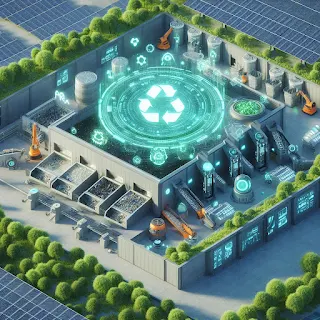Technological advancements are pivotal in enhancing the effectiveness of the circular economy, offering innovative solutions to conserve scarce resources and mitigate climate change impacts. However, the integration of technology into circular practices presents a dual-edged sword: while it can significantly improve recycling efficiency and resource management, it may also inadvertently increase carbon emissions if not managed sustainably. Investing in technological innovation, digitization, and environmental research is essential to promote sustainable development. Studies involving small and medium-sized enterprises (SMEs) in countries like China and Pakistan underscore the importance of integrating continuous education with digital solutions to achieve long-term financial and environmental objectives.
Understanding the Circular Economy
The circular economy is a sustainable economic approach focused on reducing waste and maximizing the use of resources. Unlike the traditional linear economy, which follows a 'take-make-dispose' approach, the circular economy emphasizes keeping products, equipment, and infrastructure in use for longer, thus improving the productivity of these resources. This model is based on three principles: designing out waste and pollution, keeping products and materials in use, and regenerating natural systems.ScienceDirect
The Role of Technological Advancements in the Circular Economy
Enhancing Recycling Efficiency
Technological innovations have revolutionized recycling processes, making them more efficient and less energy-intensive. Advanced sorting technologies, such as AI-powered robots, can identify and separate materials with high precision, improving the quality of recycled materials and reducing contamination rates. For instance, Samsara Eco, a climate technology start-up, has developed an enzyme that breaks down nylon 6, enabling indefinite recycling and reducing waste in the fashion industry. theaustralian
Waste-to-Energy Technologies
Converting waste into energy through technologies like anaerobic digestion and gasification provides a dual benefit: reducing the volume of waste destined for landfills and generating renewable energy. These technologies contribute to a reduction in greenhouse gas emissions and promote energy security. However, it's crucial to manage these processes sustainably to ensure that the carbon footprint of energy production is minimized.
Digital Platforms for Resource Sharing
The rise of digital platforms has facilitated the sharing economy, allowing for the efficient use of products and resources. Platforms that enable product-as-a-service models or peer-to-peer sharing can reduce the demand for new products, thereby conserving resources and reducing waste. For example, AI-powered platforms like Plastic Bank incentivize recycling by allowing individuals to trade collected plastic for goods or currency, effectively reducing plastic waste and promoting circular practices. Finextra ResearchReuters
The Dual Impact of Technology: Opportunities and Challenges
While technology offers numerous opportunities to advance the circular economy, it also presents challenges that must be addressed to prevent unintended environmental consequences.
Potential Increase in Carbon Emissions
The production and operation of new technologies can lead to increased carbon emissions, especially if they rely on fossil fuels. For instance, the manufacturing of electronic devices involves energy-intensive processes and the extraction of rare earth metals, which can have significant environmental impacts. Therefore, it's imperative to assess the life cycle emissions of technological solutions and strive for carbon-neutral or carbon-negative innovations.
E-Waste Management
The rapid obsolescence of electronic devices contributes to the growing problem of electronic waste (e-waste). Effective e-waste management strategies, including designing for disassembly, improving recycling technologies, and implementing take-back schemes, are essential to mitigate this issue. Researchers are exploring advanced techniques for recycling rare earth metals from e-waste, which could significantly reduce the environmental impact of electronic devices. The Guardian
Case Studies: SMEs in China and Pakistan
Small and medium-sized enterprises (SMEs) play a crucial role in the global economy and are instrumental in the transition to a circular economy. Studies conducted in China and Pakistan provide valuable insights into how SMEs can leverage technology to achieve sustainable development.SpringerLink circulareconomy.europa.eu
Integration of Digital Solutions
A survey involving 290 SMEs in China and Pakistan revealed that integrating digital technologies into business operations enhances circular economy practices, leading to improved economic and environmental performance. The adoption of digital tools facilitates better resource management, waste reduction, and the development of new business models aligned with circular principles. Homepage
Continuous Education and Capacity Building
The same study emphasized the importance of continuous education and capacity building for SME employees. Training programs focused on digital skills and environmental awareness enable employees to effectively implement and manage technological solutions that support circular economy initiatives. This approach not only enhances the sustainability of business operations but also contributes to long-term financial stability.
Strategies for Sustainable Integration of Technology in the Circular Economy
To maximize the benefits of technological advancements while mitigating potential drawbacks, the following strategies should be considered:
Life Cycle Assessment of Technologies
Conducting comprehensive life cycle assessments (LCAs) of technologies helps identify their environmental impacts from production to disposal. LCAs inform decision-making processes, ensuring that the adoption of new technologies aligns with sustainability goals.
Investment in Green Technologies
Allocating resources to the development and deployment of green technologies, such as renewable energy systems and biodegradable materials, supports the circular economy by reducing reliance on finite resources and minimizing environmental degradation.
Policy Support and Incentives
Governments can facilitate the integration of technology into the circular economy by implementing supportive policies and providing incentives for businesses to adopt sustainable practices. This includes funding research and development, offering tax breaks for green initiatives, and establishing regulations that promote resource efficiency.
Collaboration and Knowledge Sharing
Encouraging collaboration among businesses, research institutions, and policymakers fosters the exchange of knowledge and best practices. This collective approach accelerates innovation and the dissemination of technologies that support the circular economy.
Conclusion
Technological advancements hold immense potential to enhance the effectiveness of the circular economy in conserving scarce resources and mitigating climate change impacts. However, it is crucial to manage the integration of technology sustainably to avoid unintended environmental consequences.

No comments:
Post a Comment